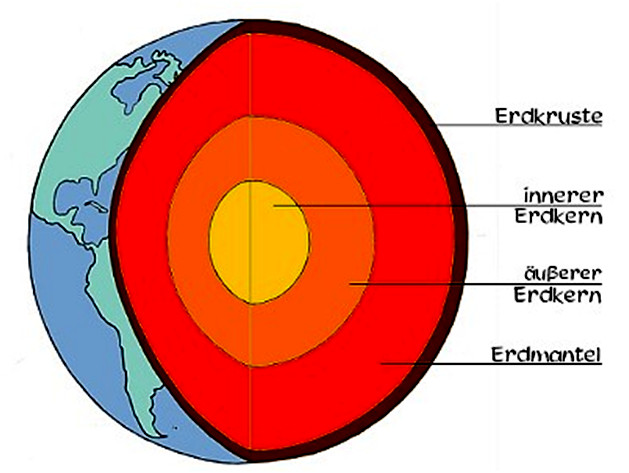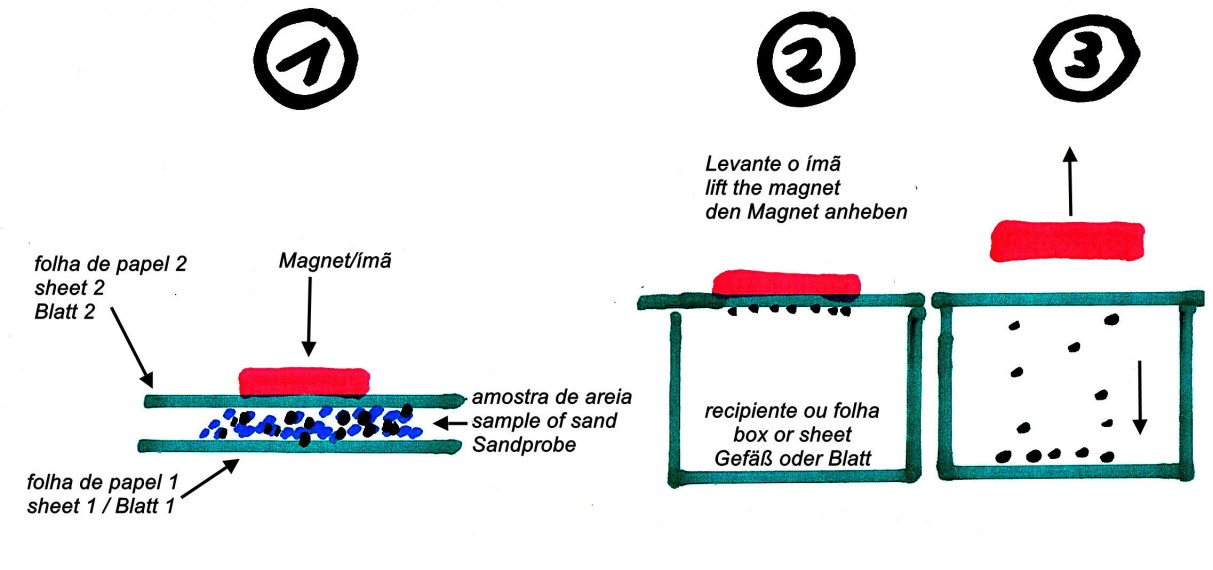The dark sands of Ribeira Grande EarthCache
The dark sands of Ribeira Grande
-
Difficulty:
-

-
Terrain:
-

Size:  (other)
(other)
Please note Use of geocaching.com services is subject to the terms and conditions
in our disclaimer.
Você precisa de 3 folhas de papel e, possivelmente, uma pequena embarcação e absolutamente um ímã.
You will need 3 sheets of paper, maybe a small box and absolutely a magnet.
3 Blatt Papier, evtl. ein kleines Gefäß sowie unbedingt ein Magnet werden benötigt
.

Português:
A areia escura da Ribeira Grande.
Inagine, você se encontra no ponto central da terra, também chamado de núcleo, onde a temperatura está acima de 5500°C. O núcleo interno é composto de ferro e níquel. A pressão no núcleo interno é tão alta, que a estrutura continua continua sólida. A extrutura do núcleo externo é líquida e composta de ferro metálico e outras substâncias. A crosta terrestre tem uma profundidade de 2900 km e temperaturas de 2500°C. Como a pressão nesta profundidade continua muito alta, a estrutura desta camada parece plasticina e é chamada de magma ou lava. Somente a última camada da terra, chamada de manto, com cerca de 30 km de espessura é totalmente sólida.

A crosta terrestre parace um quebra-cabeça gigante, dividida em enormes segmentos, chamados de placas tectônicas ou crostas continentais. O atrito entre estas placas, a instabilidade sísmica e a presença de fendas intertéctonicas possibilitam que em muitos lugares ocorram extravazamentos de lava ao meio externo.
As ilhas do Arquipélago de Açores estão numa região de alta atividade vulcânica. Nesta região se encontram as placas euroasiática, africana e americana. Somente a ilha Santa Maria, bem ao sul, não é de origem vulcânica, e sim de camadas sedimentares. Durante milhões de anos as placas continentais sofreram processos de erosão e esta areia magmática é levada pela correnteza dos rios ao mar.
Esta areia consiste de composições ferrosas, como por exemplo, magnetita. Esta areia é portanto magnética e mais pesada que outras.
Nosso Earthcache te levará à praia de Ribeira Grande. A praia é público e acessível em todos os tempos. Se no verão você prescisar pagar uma taxa de estacionamento, inicie o experimento no ponto 2!
Para fazer o login EC, responda as próximas perguntas:
1. Você consegue encontrar partículas magnéticas na areia fina?
Faça o seguinte experinmento:

- Procure areia numa parte mais sombreada e seca desta praia e coloque cerca de 1 colher de sopa em cima de uma folha de papel.
- Coloque mais uma folha de papel por cima e um magnético tamanho médio.
- Mexa um pouco a folha superior com o magnético.
- Levante a folha superior e coloque por cima de uma tigela ou uma terceira folha de papel. Somente então retire o magnético. Se você puder observar pequenas partículas pretas na tigela, você pôde encontrar ferro.
2. Faça o mesmo experimento várias vezes e avalie a porcentagem aproximada de areia magnética.
A: menos de 10%
B: de 10 - 30%
C: de 30 - 50%
D: 0%
3. Em alguns países a porcentagem de ferro e composições ferrosas na areia é bem alta, acima de 50%. Cite 3 destes países.
4. À sua frente se localiza uma barragem com cerca de 50 m de comprimento. Esta barragem é composta de material natural ou artificial? Quais materiais?
5. Em qual direção (grau) está a última faixa de terra visível do GZ?
6. Opcional: ficaríamos muito felizes em receber fotos de vocês nos lugares mencionados acima! Estas fotos não podem revelar nenhuma resposta!
Por favor note: Vocês não prescisam esperar por nossa permissão, e podem efetuar diretamente o login. O mais importante é que vocês mandem o e-mail com as respostas junto com o login! Respostas como: ‘‘mandarei a resposta mais tarde, quando retornar à casa, e quando tiver melhor ascesso ao internet“ serão apagadas junto com o login, pois na maior parte das vezes não recebemos resposta ou prescisamos perguntar várias vezes até que a resposta chegue.
English:
The dark sands of Ribeira Grande
Imagine you are in the center of the earth. In the earth's core it is about 5500°C hot. It consists of iron and nickel. Inside the inner core, the pressure is so high that the elements are in a solid form while in liquid form in the outer core. In the earth's mantle, which reaches down to a depth of 2900 kilometers and where the temperatures can reach up to 2500°C, the solid rock of our mother planet starts to melt. Because the pressure at this depth is so high it will not become liquid but instead becomes Magma. It behaves similarly to plasticine. Only the last thirty kilometers, called the earth's crust, consist of solid rock.

The earth's crust consists of a gigantic puzzle of individual plates which move against each other. The plates move again and again resulting in volcanic eruptions, ejecting ferruginous magma as a rule.
The Azores archipelago is located in an area with very high volcanic activity. At this point in the Atlantic meet the Eurasian, the African and the American plate. Only the southernmost island, Santa Maria, is not of volcanic origin. It was created by the deposition of sediments. Through millions of years persistent erosion processes finest parts of the magmatic rocks are dissolved and carried by rivers into the sea.
Those fine particles carried by rivers are rinsed and deposited by sea currents onto the beach because they are heavier than other sands. They can be found in the form of iron-containing compounds, such as, for example, magnetite. Thus the sand is magnetic.
Our Earth Cache leads you to the beach of Ribeira Grande. The beach is open for public. If an entrance fee is required in the summertime, the experiment can also be carried out at the waypoint 2.
To log the EC please answer the following questions:
1. Can you find an indication of iron sand on the beach?
Please carry out therefore the following experiment:

- Look for a dark as possible but dry spot in the fine sandy section of the beach at the coordinates. Put a spoonful-size sample on a sheet of paper.
- Cover this sample with a second sheet of paper and put a magnet on top. Now move the upper sheet with the magnet over the sample of sand.
- Now lift the upper sheet together with the magnet and move it over a third sheet or a small box and remove the magnet. Can you find on the sheet, or in the box, dark granules? If so, you have provided the evidence for iron sand.
2. Carry out the experiment several times with your taken sample and thus approximate the proportion of the magnetic sand. What is this share?
A: Less than 10%
B: de 10 - 30%
C: de 30 - 50%
D: 0%
3. In a few countries of the world the share of economically usable iron and its compounds in iron is very high, in some cases more than 50%. Name three of these countries.
4. In front of you you can see a mole, about 50m long. Does it consist of natural or artificial material? From which material?
5. In which direction (how many degrees from GZ) is the last visible headland?
6. Optionally we would be very pleased about a spoiler-free photo of you at the site.
Please note: You have not wait for our permission but send the answer e-mail immediately together with the log! No logs like: "Will send the answers later, when back home, when having better internet", etc. Such kind of logs we will delete without prior notification.
Für die deutsche Übersetzung klicke/for the german translation click hier/here.
Additional Hints
(No hints available.)